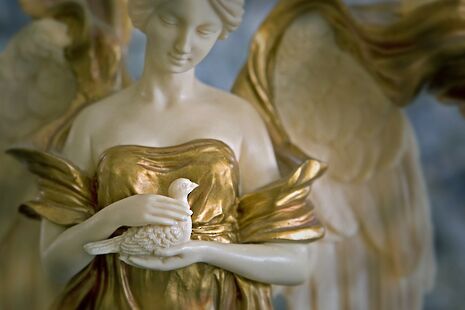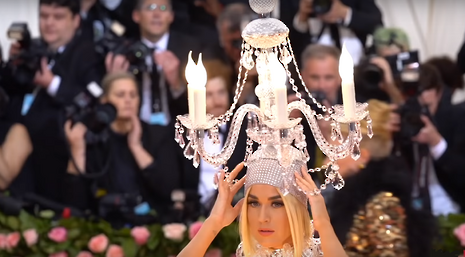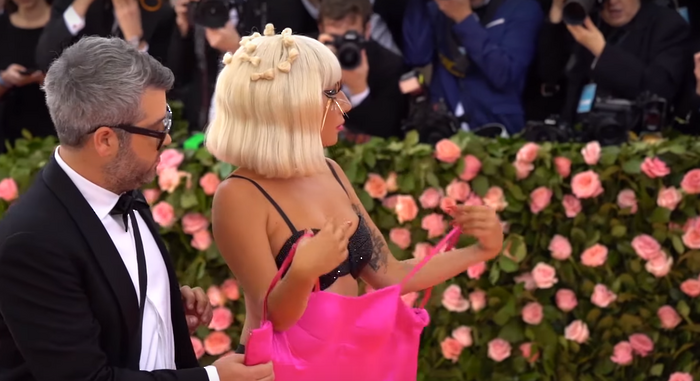Camp notes on art
Kate Robertshaw explores the art world influences embodied by the Met Gala guests’ ‘Camp’ outfits

Feathers, celebrities stripping and human chandeliers; not an adult remake of Beauty and the Beast, but the 2019 Met Gala, a night of experimental high fashion held every year to celebrate the opening of the Metropolitan Museum of Art's latest exhibition. This year the theme is ‘Camp: Notes on Fashion’, taken from the Susan Sontag essay, ‘Notes on Camp’.
Sontag’s musings describe a phenomenon present throughout art history, a way of ‘seeing the world as an aesthetic phenomenon’. This sensibility has much historical potency, with queer culture being the driving force and influence behind its prominence, thanks to the likes of RuPaul’s Drag Race and the popularity of ‘yas queen’, often attributed to its appearance in Broad City. But the idea of ‘Camp’ has often been connected particularly with Art Nouveau, a period that adored all things exaggerated and, as Sontag put it, ‘things-being-what-they-are-not’. Art Nouveau objects typically convert one thing into something completely different: lighting fixtures take the form of flowering plants, orchids are actually iron rods.
Tracee Ellis Ross glided down the red carpet as a real-life portrait
The best designers played on this. Katy Perry, for example, is literally placed into the spotlight by her Jeremy Scott chandelier dress. She appeared so decadent that she would not have been out of place as a centerpiece in an Art Nouveau building (an effect only strengthened by the fact that the lights actually worked), and the suggested elegance of a chandelier dramatized and heightened the grace of a typical Met Gala dress in true ‘Camp’ fashion. Bette Midler became a genuine social butterfly to match the ones on her Michael Kors gown and top hat: glittering like 19th-century stained glass, the delicately-crafted creatures gave the outfit an air of life. Carrying on the theme of objects, Tracee Ellis Ross glided down the red carpet as a real-life portrait, her Moschino black gown adorned with a large gold picture frame. Ross reflected the theatrical side of the media and photography, captured by the press on her every step as both portrait and costume.

The ‘Camp’ present in the Art Nouveau period also pervades the art of classical Athens. Andrew Bolton, director of the Met’s Costume Institute, traced the word camp back to the French verb se camper, meaning to strike an exaggerated pose, which in turn strongly resonates with the classical pose ‘contrapposto’ where the figure creates a more dynamic appearance by putting most of their weight on one side. Art in Athens was known for mathematical formula rather than naturalistic tendencies when it came to the presentation of beauty. This calculated appearance is certainly in tune with the artifice of the ‘Camp’ theme, something many celebrities adopted to present and highlight their own ideal of beauty.
This portrait of exaggerated femininity is ‘Camp’ in its theatrical nature and preference for aesthetics over naturalism
Kim Kardashian West’s Mugler ‘wet-look’ dress was certainly a work of artifice, the fabric clinging to her body and the dripping diamonds imitating falling water. The idea of wet drapery was a phenomenon of 5th century classical Athenian art, and was used not to portray a realistic vision of a woman, but to accentuate the perceived femininity of the figure. Here we see just that in the dress’ amplification of Kardashian West’s hips and breasts. This portrait of exaggerated femininity is ‘Camp’ in its theatrical nature and preference for aesthetics over naturalism, a preference with which the Ancient Greeks were well acquainted.
The posed nature of art and fashion was illustrated by Ezra Miller’s Burberry costume. The initial part of his outfit revealed him wearing a cape and lifelike mask, thus portraying a posed masculine exterior, and it is only with the removal of this costume that he reveals his multiple identities underneath. This performance of gender and bending of the conventions of masculinity embodies the spirit of ‘Camp’. And as a genderqueer individual, Miller recalls an important tradition of the self-expression and boldness of the queer community, that has often been praised as one of the foundations of ‘Camp’. The conscious nature of his first look reminds us both of the formulaic and the posed nature in which classical Athenian statues portrayed men and masculinity.
The Doryphoros by Polykleitos is a quintessential example of this posed state of masculinity in 5th century Athens. The overly defined body demands the viewer’s attention due to its imposing ideal of virility. Like Ezra Miller, he too could be wearing a mask, as he glances out expressionless, devoid of any individual features. The mask-like face and physicality representing strength and beauty became the standardized way to represent masculinity, though it would be clear to anyone examining him that he is not an individual, but rather an embodiment of the ‘perfection’ of masculinity.
The imitation of these the Art Nouveau and the classical resulted in a night not just fueled with sequins and frills but with some adept artistic nods to the spirit of Sontag’s ‘Camp’. Through the lens of high fashion and the spectacle of such an event emerges a celebration of art in its many forms. ‘Camp’ is a multifaceted sensibility that encompasses artifice, the exaggerated, challenges the typical view of what constitutes ‘good taste’ and is profoundly embedded within the history of art and fashion. Maybe this night is an indication of the revival of ‘Camp’. ‘Camp’ is not just for the buildings of the Art Nouveau period or statues of classical Athens, it is a spirit of the now and has been infused into mainstream culture. The diverse dress of the night underscores ‘Camp’ as a certain boldness, one that urges the individual to consider their own aesthetics and engage in a form of self-expression.
 News / Cambridge academics stand out in King’s 2026 Honours List2 January 2026
News / Cambridge academics stand out in King’s 2026 Honours List2 January 2026 Interviews / You don’t need to peak at Cambridge, says Robin Harding31 December 2025
Interviews / You don’t need to peak at Cambridge, says Robin Harding31 December 2025 Comment / What happened to men at Cambridge?31 December 2025
Comment / What happened to men at Cambridge?31 December 2025 Features / “It’s a momentary expression of rage”: reforming democracy from Cambridge4 January 2026
Features / “It’s a momentary expression of rage”: reforming democracy from Cambridge4 January 2026 News / Varsity’s biggest stories of 202531 December 2025
News / Varsity’s biggest stories of 202531 December 2025










